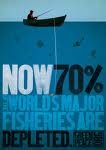Fishing, once a matter of casting a net into the sea or hooking with rod and line is under increasing pressure as the world struggles to feed its hungry mouths.
Depleted marine stocks, environmental concern about fish farming in much of the world and ever greater demands on limited water supplies have put the squeeze on resources.
The UN Food and Agricultural Organization (FAO) and World’s Food Summit pledged to reduce the number of undernourished to 400 million by 2015.
There are 800 million people lacking enough food to meet their basic nutritional needs; must act to increase production significantly; and fishing that is expected to make its contribution.
It is noted by FAO’s fisher experts that the estimated of the total fish supply is no more than 1 to 2 percent per year while the wild resources are almost close to the limit where room for expansion is basically limited to non traditional stocks.
One such stock is the shrimps called krill which also are staple for whales and therefore environmentally sensitive.
However, cutting the size of fleets to reduce overfishing could increase the size of catches and reduce costs due to greater efficiency.
 But another way of increasing the amount of fish caught for food lies simply in its change of usage. Of the 100,000 tons of fish which is being caught, a good bulk goes to fish meal which is being used in feed production for chicken, cows, salmon and other fishes.
But another way of increasing the amount of fish caught for food lies simply in its change of usage. Of the 100,000 tons of fish which is being caught, a good bulk goes to fish meal which is being used in feed production for chicken, cows, salmon and other fishes.
Ironically, fish farms that are producing salmon and other luxury species consume more fish than they produce, with huge amount of marine fish being grounded to feed them.